Lissa Johnston's Blog, page 24
January 17, 2016
Self-published Book Covers: Nothing To Horse Around With
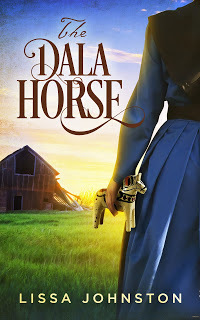 The new cover redesign
The new cover redesignby ebooklaunch.comIf you've been following me here or on social media, you know I had my first experience with self-publishing with my book The Dala Horse in July of 2015. I've learned so much and am still learning, which is the reason for today's blog post.
ICYMI, I have experience with traditional publishing. Some years ago I published several non-fiction books for kids. You might find my name on a spine somewhere in your local elementary school library. I enjoyed the work, but itched to kick over the traces of that very structured niche. I had lots of ideas for fiction projects for readers of all ages.
Fast forward a few years: by the time I was ready to get back into writing full-time, technology had revolutionized the publishing industry. Self-publishing had lost its stigma. Authors could publish their work at will with the simple push of a button, for little or no cost. This was the perfect setup for me. I'm moderately tech savvy. I envisioned a scenario where all my unfinished manuscripts could be up and ready for sale online in no time flat (assuming I actually finished them first, of course).
Needless to say, this was wildly optimistic. I did manage to get one book (The Dala Horse) published in 2015. I had a pretty steep learning curve, which I've discussed in previous posts. But I got 'er done.
One of the many things I didn't anticipate is the topic of this post (and at long last we have arrived at the topic!). While researching my book, I found an image I was dying to incorporate into the cover of The Dala Horse. It was an adorable image of a little wooden dala horse. I felt it perfectly captured the rustic charm of the toy as well as the tone of the book and the personality of my 10-year-old main character. I was determined to use it somehow. I purchased the artwork from the artist on Etsy and secured her permission to use its likeness. There was only one problem: I have zero artistic skills. I have some tech skills, but as far as composition and design, forget it.
Now here's where I made one of many mistakes: I told myself the art was so adorable, it would stand
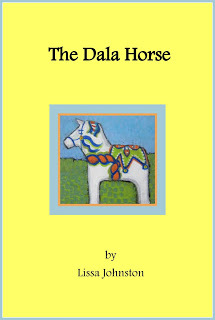 That little horse is so cute,
That little horse is so cute,amirite??on its own. Why do I need to spend the money on a cover designer? I have a computer. I have some tech skills. So I just dropped the image into a Word doc or a Paint doc, I forget which, threw some font at it for the title and author name, and let 'er rip.
I can hear your groans and see your heads shaking all the way from the Carolinas.
I turned a blind eye to this glaring rookie mistake for the first six months The Dala Horse was out there. When you've just self-published your first book, that achievement tends to overshadow other little imperfections that gradually but inevitably present themselves as time passes, like mildew stains through a cheap coat of paint. I marketed my buns off, at least as far off as DIY marketing will take you - more on that in a future blog post. And as you can probably guess, sales were dismal. Reviews were positive, for the handful of people who managed to find the book. But sales could be counted on one set of fingers and toes.
In the meantime, information junkie that I am, I continued to devour endless articles on self-publishing (among other things). Many of them remonstrated with new authors against doing their own covers. One, in particular, really hit home with me with the phrase 'cover crush'. Yes. I had a crush on my cover. It was time for a proper cover, one that did the story justice.
I felt very sad about this as I really, really loved the little horse by Ellen Haasen. But after reading an article about researching what sells in your genre, and the components of a compelling cover, I decided it was time to retire my little dala horse in favor of something more polished.
I was all set to hire it out, pay the money, and work hard on marketing to at least earn the cost of the cover back. Until. I found a page on Joanna Penn's marvelously helpful website about book covers. And tucked away on that page was a link to Derek Murphy's website. Mr. Murphy has designed many attractive book covers. He has also published several free videos that take you through the DIY cover design process step by step. He has even developed a free cover design program for those of us who cannot afford to purchase their own copy of Photoshop.
As I mentioned twice already, I have some tech skills and am pretty coachable, so I thought I would give this DIY thing one more go before I paid good cash money for someone else to do the cover. In my mind, all I was lacking was a robust photo editing program. I had done my research on the competition's covers in my genre. Thanks to Mr. Murphy and others, I learned about colors and fonts and composition and all that stuff. I knew where to get good stock photos with the proper licenses and permissions. I felt I was ready to give it a go.
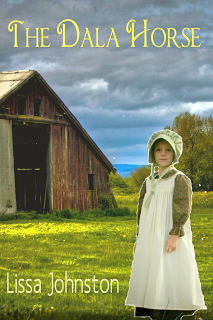 My DIY draft using Mr. Murphy's
My DIY draft using Mr. Murphy'sgraphics editor. Still needed some
tweaking, but not half bad. Too
bad it was so buggy.I spent about a day, all told, watching Mr. Murphy's videos, including all his bloopers and goofs mixed in with the quality content. Some might call these mistakes charming. Others may wonder, why not take the time to edit all that stuff out? Who am I to judge?
I spent another day playing with his photo editor. I say playing. It was actually pretty hard work. It took me probably half a day to track down some images that I felt were right for the story that might potentially be available to me. It took me another half day editing said images, erasing backgrounds, and playing with all the cool filters. But I finally got the hang of it, had a couple of new covers drafted, and was feeling cautiously optimistic about being able to create a cover that was, if not the best cover in my genre, def not the worst (not by a long shot - apparently I'm not alone in my DIY bullheadedness). So the next morning I get up, rarin' to go, envisioning a new cover for my book by the end of the day, and . . . couldn't get the photo editor program to open my saved files. The same files that will only work in that specific editor. I could open new files and start over to my heart's content. But re-open an existing file? Sorry, no can do. There went three full days of my time, time I should've spent on my current three book series that I'm hoping to start publishing Q1 2016. Was I mad? You could say that.
It was at this point (finally!) I decided to stop goofing around and just hire the dang thing out. Back to Penn's site, clicked on several of her recommendations, and decided to try one called ebooklaunch. In less than half the time I wasted with the Murphy product, I had a great-looking cover, using images I didn't have to worry about violating privacy, licensing or other copyrights. The staff was great. They were prompt and helpful and friendly, and I am thrilled with the outcome.
If I had a fancy computer and owned a copy of Photoshop or something similarly robust, as well as an account at Shutterstock or other similar photo resources, and wanted to devote the time, I could probably come up with some covers on my own that are about equal to many you see on Amazon. But I just don't want to do that at this point in my writing life. I'm already spending enough time on social media and marketing and blogging. The cover is too valuable a piece of my marketing puzzle to leave to chance.
Even though I wasted about six months of valuable marketing time on a sad little DIY cover, all is not lost. This experience does leave me feeling a little more knowledgeable design-wise. Although his photo editor needs work, Mr. Murphy's advice at his website regarding the components of an effective book cover design is sound. It allowed me to streamline the process with ebooklaunch by giving them specific input on the colors, background, setting, and other components of the cover based on other covers in my genre and the various story elements I wanted to portray. Prior to deciding to use ebooklaunch, I had set up a private Pinterest board and stashed all images there of both images I either wanted to use or was inspired by, as well as images of other covers I admired either in tone or genre or some other intangibles. I feel like this small step was useful in the getting-to-know-you process with the cover designer and contributed to the quick and satisfactory result.
It's too soon to know who I will use to design my next book cover. As I mentioned, it's a three book series. It's in a different genre, so I need to do some more research on that genre to get a feel for what appeals. I've already set up a private Pinterest board for this project and have started accumulating images. I have no hesitation using ebooklaunch again. One thing I know for sure: I would no more design the cover myself than I would give myself a tattoo. That's something best left to the professionals.
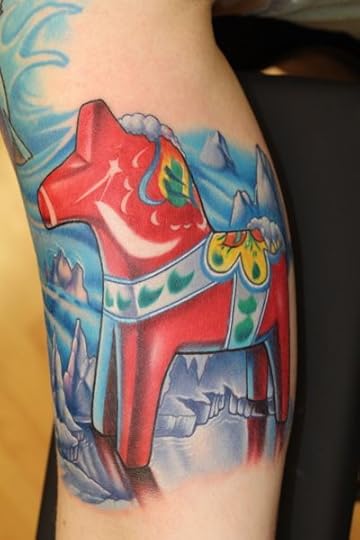 No, this is not me, but you get my drift
No, this is not me, but you get my drift
Published on January 17, 2016 14:58
January 6, 2016
Cheating Death: Revenants of the Old West
 This drawing is often associated with Hugh
This drawing is often associated with HughGlass. Unfortunately I have been unable
to discover why or who drew it. Still,
pretty cool. The bear claw necklace
is an amusing touch.Be still, my historian heart! Ever since I saw the trailer for The Revenant and later heard it was based on the life of Hugh Glass, I've been beside myself with glee. Colorful characters like Glass are the reason I converted to full-on history nerd. I can't argue with those who say history is boring. It can be very tedious if one is bombarded with nothing but names and dates and memorization. But people love a good story, and history is full of good stories.
When I was getting my Masters in history back in the day, I focused on American history prior to 1900. Exploration of both the New World and the American West were my favorite topics. There was just something about the bravery and drive of individuals who were willing to forge ahead into unknown lands that captivated me. So when I heard about this movie, I dug out my old handwritten notes (transcribed while spending endless afternoons at the university library, which, thanks to some lingering pack rat tendencies, were still carefully preserved in a few yellowing folders). This method of acquiring knowledge is now laughably quaint. I can now find ten times the amount of information in one tenth the time thanks to Google.
With the advent of The Revenant in theaters soon, there are many articles online about Mr. Glass and his amazing life. I'll give you the broad details and if you're interested in learning more, that's wonderful, and that's what Google is for. Much of what we know about Hugh Glass is from word of mouth from himself and others, hearsay, tall tales bordering on mythology. Who knows how much of this really happened. Mountain men not only lived adventurous lives; they were known for their propensity for spinning yarns, especially when regaling greenhorns like newspaper reporters and dime novelists. Indeed, at the annual trapper 'rendevous' - think Sturgis without the motorcycles - a liar's contest was featured, along with games, gambling, and drinking.
Mr. Glass is most well known for surviving being left for dead after a grizzly bear attack while on a scouting expedition in South Dakota in 1823. His will to survive (plus IMO his thirst for revenge on the two comrades who abandoned him to his fate) drove him to drag himself 100 miles back to the nearest outpost, Fort Kiowa. I don't know if this story line will appear in the movie, but prior to his frontier days, Glass was rumored to have escaped impressment into the crew of pirate Jean Lafitte by jumping ship and swimming two miles to the Texas coast.
Amazingly, Glass is hardly the lone example of mountain men for whom cheating death was part of the job description. I've put together a chart to summarize a few other mountain men to demonstrate the similarities. And by no means is this list conclusive. These nuts were as plentiful as acorns on an oak.
Mountain ManSurvived Grizzly AttackAttacked by IndiansKilled by IndiansReturned to CivilizationDied in bedBook Written AboutMovie Made AboutHistorical Marker(s)Hugh Glass 1785-183318231823, 1824Arikaras, 1833✓The Revenant (2015)Shadehill SDJohn 'Liver-Eating' Johnson 1900 aka 'Crow Killer'too many to count✓✓✓Jeremiah Johnson (1972)Cody WYJohn Colter 1744-18131809 (2), 1810✓✓✓Stuart's Draft VAJim Bridger 1804-1881✓✓✓Bridger MTKit Carson 1809-186818341833, 1838, 1843, 1846✓✓✓Kit Carson (1940)manyJedediah Smith 1799-183118231823, 1827, 1828Comanches, 1831✓many
Less well-known, but equally colorful:
Mike Fink, the Ndamukong Suh of mountain men. He reputedly bit off the nose of a fellow mountain man during a fight, and killed another during a drunken game of William Tell.Jim Clyman, who became separated from his companions and survived a two month hike to Fort Atkinson by employing such survival skills as killing his dinner with leg bones scavenged from a wild horse skeleton."Old Bill" Williams, a former Methodist minister known for his eccentric ways (and to be thought eccentric by mountain men should tell you something about his personal habits). While setting beaver traps, he was beset by three Blackfoot Indians, who shot him twice with arrows and made off with his rifle, Old Fetchem. Guns being the frontier equivalent of gold bars, Old Bill was not satisfied to escape with his life. He meant to recover his rifle. He dug out the arrowheads, tracked the Blackfeet, and killed two of them as the slept off a big dinner of fresh buffalo. The third he scalped but allowed to escape so as to spread the word he was not a trapper to be trifled with.
You might be wondering why in the world anyone would want to embrace a lifestyle in which run-ins with grizzly bears and hostile natives was fairly common. Then, as now, it was partly due to opportunity. After Thomas Jefferson bought the Louisiana from France in 1803 and the Lewis and Clark expedition explored over 800,000 square miles of land and found it exceeded expectations, opportunists of every stripe headed west. These were the entrepreneurs of their era, unwilling or unable to fit into society's existing employment structure: craftsmen, teachers, farmers, the military. The requirements for having a go at the frontier life were simple. Can you hunt? Can you fight? You're hired. Many were also attracted to, in the words of author John Myers Myers, "the way of life in a region so remote from all fountainheads of law and decorum". Wild West, indeed.
It's gratifying that at least one person other than me (the author of the book The Revenant is based on, for one) finds this stuff so interesting. All of these other characters deserve a book and a movie and a television series of their own. History nerds: keep cranking out content! and maybe one day one of our names will appear in the credits of a film starring an impossibly handsome actor made impossibly grubby thanks to some makeup artist's fine skills. You'll have to wait until the final credits, but it'll be worth it to see: 'based on the book by [insert your name here]'.
Recommended reading:
Bravos of the West by John Myers Myers
A Life Wild and Perilous by Robert M. Utley
Published on January 06, 2016 10:37
Cheating Death: The Revival of Revenants of the Old West
 This drawing is often associated with Hugh
This drawing is often associated with HughGlass. Unfortunately I have been unable
to discover why or who drew it. Still,
pretty cool. The bear claw necklace
is an amusing touch.Be still, my historian heart! Ever since I saw the trailer for The Revenant and later heard it was based on the life of Hugh Glass, I've been beside myself with glee. Colorful characters like Glass are the reason I converted to full-on history nerd. I can't argue with those who say history is boring. It can be very tedious if one is bombarded with nothing but names and dates and memorization. But people love a good story, and history is full of good stories.
When I was getting my Masters in history back in the day, I focused on American history prior to 1900. Exploration of both the New World and the American West were my favorite topics. There was just something about the bravery and drive of individuals who were willing to forge ahead into unknown lands that captivated me. So when I heard about this movie, I dug out my old handwritten notes (transcribed while spending endless afternoons at the university library), which, thanks to some lingering pack rat tendencies, were still carefully preserved in a few yellowing folders. This method of acquiring knowledge is now laughably quaint. I can now find ten times the amount of information in one tenth the time thanks to Google.
With the advent of The Revenant in theaters soon, there are many articles online about Mr. Glass and his amazing life. I'll give you the broad details and if you're interested in learning more, that's wonderful, and that's what Google is for. Much of what we know about Hugh Glass is from word of mouth from himself and others, hearsay, tall tales bordering on mythology. Who knows how much of this really happened. Mountain men not only lived adventurous lives; they were known for their propensity for spinning yarns, especially when regaling greenhorns like newspaper reporters and dime novelists. Indeed, at the annual trapper 'rendevous' - think Sturgis without the motorcycles - a liar's contest was featured, along with games, gambling, and drinking.
Mr. Glass is most well known for surviving being left for dead after a grizzly bear attack while on a scouting expedition in South Dakota in 1823. His will to survive (plus IMO his thirst for revenge on the two comrades who abandoned him to his fate) drove him to drag himself 100 miles back to the nearest outpost, Fort Kiowa. I don't know if this story line will appear in the movie, but prior to his frontier days, Glass was rumored to have escaped impressment into the crew of pirate Jean Lafitte by jumping ship and swimming two miles to the Texas coast.
Amazingly, Glass is hardly the lone example of mountain men for whom cheating death was part of the job description. I've put together a chart to summarize a few other mountain men to demonstrate the similarities. And by no means is this list conclusive. These nuts were as plentiful as acorns on an oak.
Mountain ManSurvived Grizzly AttackAttacked by IndiansKilled by IndiansReturned to CivilizationDied in bedBook Written AboutMovie Made AboutHistorical Marker(s)Hugh Glass 1785-183318231823, 1824Arikaras, 1833✓The Revenant (2015)Shadehill SDJohn 'Liver-Eating' Johnson 1900 aka 'Crow Killer'too many to count✓✓✓Jeremiah Johnson (1972)Cody WYJohn Colter 1744-18131809 (2), 1810✓✓✓Stuart's Draft VAJim Bridger 1804-1881✓✓✓Bridger MTKit Carson 1809-186818341833, 1838, 1843, 1846✓✓✓Kit Carson (1940)manyJedediah Smith 1799-183118231823, 1827, 1828Comanches, 1831✓many
Less well-known, but equally colorful:
Mike Fink, the Ndamukong Suh of mountain men. He reputedly bit off the nose of a fellow mountain man during a fight, and killed another during a drunken game of William Tell.Jim Clyman, who became separated from his companions and survived a two month hike to Fort Atkinson by employing such survival skills as killing his dinner with leg bones scavenged from a wild horse skeleton."Old Bill" Williams, a former Methodist minister known for his eccentric ways (and to be thought eccentric by mountain men should tell you something about his personal habits). While setting beaver traps, he was beset by three Blackfoot Indians, who shot him twice with arrows and made off with his rifle, Old Fetchem. Guns being the frontier equivalent of gold bars, Old Bill was not satisfied to escape with his life. He meant to recover his rifle. He dug out the arrowheads, tracked the Blackfeet, and killed two of them as the slept off a big dinner of fresh buffalo. The third he scalped but allowed to escape so as to spread the word he was not a trapper to be trifled with.
You might be wondering why in the world anyone would want to embrace a lifestyle in which run-ins with grizzly bears and hostile natives was fairly common. Then, as now, it was partly due to opportunity. After Thomas Jefferson bought the Louisiana from France in 1803 and the Lewis and Clark expedition explored over 800,000 square miles of land and found it exceeded expectations, opportunists of every stripe headed west. These were the entrepreneurs of their era, unwilling or unable to fit into society's existing employment structure: craftsmen, teachers, farmers, the military. The requirements for having a go at the frontier life were simple. Can you hunt? Can you fight? You're hired. Many were also attracted to, in the words of author John Myers Myers, "the way of life in a region so remote from all fountainheads of law and decorum". Wild West, indeed.
It's gratifying that at least one person other than me (the author of the book The Revenant is based on, for one) finds this stuff so interesting. All of these other characters deserve a book and a movie and a television series of their own. History nerds: keep cranking out content! and maybe one day one of our names will appear in the credits of a film starring an impossibly handsome actor made impossibly grubby thanks to some makeup artist's fine skills. You'll have to wait until the final credits, but it'll be worth it to see: 'based on the book by [insert your name here]'.
Recommended reading:
Bravos of the West by John Myers Myers
A Life Wild and Perilous by Robert M. Utley
Published on January 06, 2016 10:37
December 6, 2015
There's No Substitute For A Good Substitute
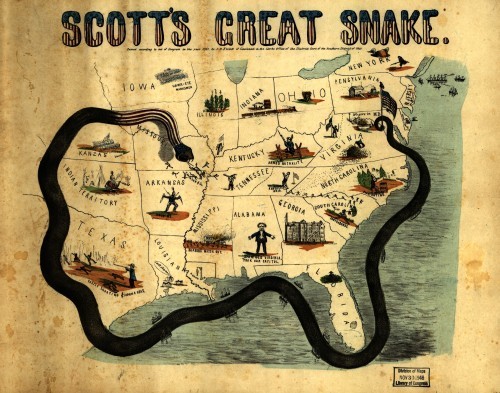 Your amusing factoid for the day: the blockade was called
Your amusing factoid for the day: the blockade was calledthe 'Anaconda Plan' because it was supposed to squeeze
the life out of the South. Wait, one more: the Scott referenced
on the map was General Winfield Scott, U.S. Army. At
6'-5" and 300 pounds, when people say he was the
inspiration for the term 'Great Scott!', I believe it.My latest book, The Dala Horse , is set in post-Civil War Texas. As I was researching that era, I came across an amusing compilation of recipes for coffee substitutes. The Union/Yankees/Northerners included the port of Galveston as part of their naval blockade to cut off supplies to the South. Many items, not just coffee, were unavailable for years. Newspapers went kaput because newsprint was no longer available. Although many folks were used to making their own clothing at that time, they had the additional fun of having to make their own fabric during the war as well, since bolts of woven fabrics were scarce. But of all the things on hiatus in the South during and for a time after the Civil War, coffee was the most missed and most celebrated upon its return.
When contemplating this post I was sorely tempted to try out some of these substitutions and report on how they tasted compared to the real thing. There's just one problem. I don't drink coffee, mainly because I don't like coffee. I don't think I could have rendered a fair opinion. Roasted lug nuts would have probably tasted as good or better than actual coffee to me.
Then, as now, coffee was grown mostly in tropical hemispheres and imported for our consumption. So getting a crate of coffee beans delivered from Sao Paolo to San Antonio wasn't gonna happen with Great Scott's Anaconda snappishly guarding the door. But lots of other things grew wild and rampantly in the warm American South and were quickly pressed into service. Anything that could be roasted, ground, and brewed with hot water, was. Everything from corn meal to beets, rye, asparagus (seeds, not spears - mercy, no!), acorns, chicory, turnips, barley, parsnips, wheat, field peas, okra seeds, sweet potatoes, popcorn, cotton seeds, and tree bark was put forth. I kid you not. Tree. Bark. I will quote the actual 'receipt', as they were wont to say for 'recipe' back then, lest you not believe me:
Take tan bark, three parts; three old cigar stumps and a quart of water, mix well, and boil fifteen minutes in a dirty coffee pot. Arkansas True Democrat, October 17, 1861
And you thought Starbucks had exhausted all possible coffee iterations. If this really was a thing, it goes a long way toward explaining coffee drinker halitosis.
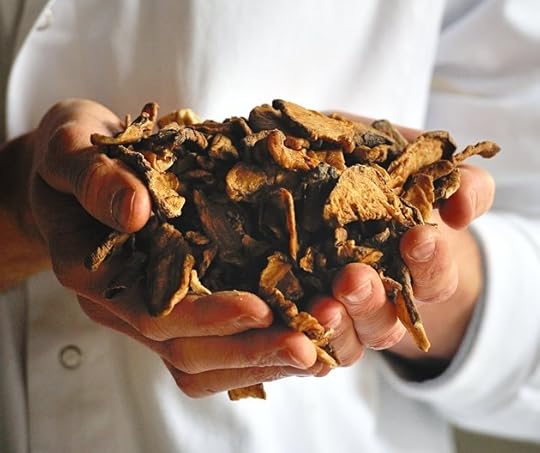 Chicory root. It's a French thing.Every substitute suggested was strongly backed by the person suggesting it, claiming it was as good or better than the real thing. This is utter nonsense, of course (except maybe for the chicory, which I understand is still popular as a coffee ingredient in certain parts of the south). People couldn't wait to get their coffee beans back in the pot after the war. I wish the acorn recipe had panned out. I would be sitting on an acorn coffee goldmine thanks to the massive and prolific jack oak tree in my front yard. Instead, I'm forced to rely on the local squirrel population to remove them from underfoot, bless their hearts. If they can learn to operate a wheelbarrow, they can use mine, no charge.
Chicory root. It's a French thing.Every substitute suggested was strongly backed by the person suggesting it, claiming it was as good or better than the real thing. This is utter nonsense, of course (except maybe for the chicory, which I understand is still popular as a coffee ingredient in certain parts of the south). People couldn't wait to get their coffee beans back in the pot after the war. I wish the acorn recipe had panned out. I would be sitting on an acorn coffee goldmine thanks to the massive and prolific jack oak tree in my front yard. Instead, I'm forced to rely on the local squirrel population to remove them from underfoot, bless their hearts. If they can learn to operate a wheelbarrow, they can use mine, no charge.There have been many other instances food shortages since the 'unpleasantness' between the North and the South. Many items, including sugar and dairy products, were rationed during World War II. But this was before my time. More recent supply chain interruptions have not been war-related, thank goodness. We had the 2015 Blue Bell listeria scare. And the Cheesepocalypse (the 2014 rumors of a Velveeta shortage). And the temporary Twinkie extinction of 2013. All three products are restored or soon will be, and their consumers are ecstatic - even though their waistlines won't be. (Is anyone else worried that the most recent shortages have occurred not in an effort to conserve resources for a nobler effort, but because of faulty business or manufacturing models of over-processed, unhealthy junk food we shouldn't be eating anyway?)
That's not to say current generations haven't experienced sacrifice. They've come up with a way to inflict one upon themselves. It's called a 'diet'. Just talk to anyone who has voluntarily given up meat or pasta or sugar. Their behavior is eerily similar to the pioneers who longed for their coffee beans. Here's the modern version of the Five Stages Of Deprivation:
Reminiscing - stories of how things used to be 'before', when their metabolism was fully functioning or before they learned more than they wanted to know about the processed food industry.Self-pity - The sad little tear quickly wiped away after fruitlessly perusing a menu at a chic new bistro for something they are willing to eat, and having to settle for a side salad.Ingenuity - The bizarre formulations concocted in a desperate attempt at approximating the missing item. Google 'gluten-free brownie recipe'. False Confidence - The insistence that their substitute food of choice is just as tasty as the original. For the best example of this, sit next to your vegan cousin next Thanksgiving.Ecstasy - The rapturous expression at the inevitable slip when they allow themselves a nibble of the forbidden item.
I wish it weren't so, but I've learned these things from sad experience. Our coffee supply is fine. But the ice cream - well, that's another story. Here at my house, we're somewhere between Self-Pity and Ecstasy, waiting for the first Blue Bell delivery in months to arrive at our local grocery store. They better hurry. We're starting to run out of tree bark and cigar stumps.
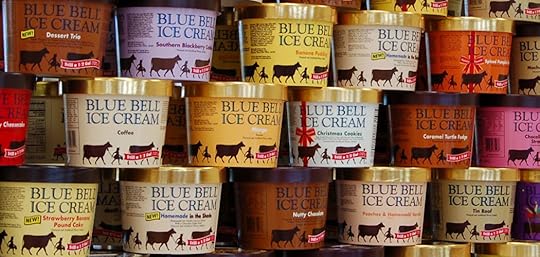
Published on December 06, 2015 20:00
November 29, 2015
4 Things I Didn't Learn From NaNoWriMo 2015 (And 3 Things I Did)
 As National Novel Writing Month (NaNoWriMo) comes to a close, gird your loins for the usual flood of post mortem blog posts (like this one). You will see some of the same points made in many of them (like the ones following shortly). That's not to say they're not legitimate. They are - for first-time NaNo participants. They're dying to tell you how they learned how to crank out a respectable amount of words per day, whether they felt like it or not. I learned not to edit and just write, they'll say. But I think NaNo veterans will agree with me when I say these observations fall under the category of No News Here. Yes, I did learn those things the first time I did NaNo. My writing discipline improved as a result. But I hope like heck I'm not snared in a writer's version of Groundhog Day, limited to learning the same stuff over and over. I like to think I come away with something new each time I participate.
As National Novel Writing Month (NaNoWriMo) comes to a close, gird your loins for the usual flood of post mortem blog posts (like this one). You will see some of the same points made in many of them (like the ones following shortly). That's not to say they're not legitimate. They are - for first-time NaNo participants. They're dying to tell you how they learned how to crank out a respectable amount of words per day, whether they felt like it or not. I learned not to edit and just write, they'll say. But I think NaNo veterans will agree with me when I say these observations fall under the category of No News Here. Yes, I did learn those things the first time I did NaNo. My writing discipline improved as a result. But I hope like heck I'm not snared in a writer's version of Groundhog Day, limited to learning the same stuff over and over. I like to think I come away with something new each time I participate.Something else in the No News Here category: I am not great when it comes to planning ahead. This year I had grand intentions of using my Scrivener app to have my new novel all outlined and plotted and charted and ready to go, and all I had to do was fill in the blanks scene by scene. But I fiddle-farted around until it was almost too late, and didn't finish my outline done before November 1. This was not the end of the world, especially since I still don't know exactly how the story will wind up. Let's just say it's like motor oil: in a fluid state, very much subject to change.
Okay, so now you know what I didn't learn. Here's what I did learn.
As I mentioned, I became even more comfortable with Scrivener. I learned how to use the Label function for categorizing and the Corkboard for storyboarding. I used the split screen feature extensively, viewing my notes in one screen while composing in the other. I used the Inline Annotation feature to boost word count by letting notes to myself stay within the manuscript, but in such a way that is easy to spot and relocate when the time comes. I learned Scrivener has a Name Generator feature which is pretty cool. Overall, I am really loving Scrivener. It's around $40 but they run a special during NaNo. I think I saw it was $25. Wish I had known this last year and I would've waited until November to buy it. I paid full price.I blogged about my Story Forge cards recently. I used the heck out of them this NaNo. Whenever I got stuck, out came the cards and I did a spread, usually a character backstory, which stimulated some very productive ruminations. The cards are $20 plus shipping, but they were worth every penny this NaNo. Speaking of which, this year is the first time I really gave much thought to character backstories. Thanks to the marriage of my stream-of-consciousness ramblings with the ideas suggested by the Story Forge spreads, I now have fully-formed backgrounds supporting all of my characters that informs their actions in what I think is a believable way. I feel I know them better. And knowing them better suggests all sorts of interesting plot twists and shadings and nuance that I may not have otherwise.
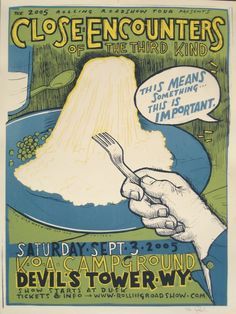 I don't do NaNo with the expectation of having a near-perfect project by December 1, which I edit and publish by the end of the year (the same year). Instead, I expect to have at least 50,000 words of hot mess that is the massive, shapeless mound of mashed potatoes from which I will sculpt my Devil's Tower (Close Encounters fans will get this. Others, that's what Google is for). I estimate around half of my 50,000+ word hot mess (and yes, I did finish, first time ahead of schedule, note blue badge of courage proudly displayed at upper right) is stream-of-consciousness stuff: me talking to myself about the story; spit-balling; spelling out various scenarios; why they have potential; why this might work but that probably won't; the pros and cons of adding or changing characters; tinkering with the setting; and so forth. Most of this material will be shifted to Notes and Research and other support folders and mercifully will not show up verbatim in my novel. I don't consider this cheating, or filler, and here's why: it's time and word count spent focused on the project and has a direct and productive connection to the finished product. Since this is a YA story, I estimate I am 60-70% finished with the first draft. Not bad for only 30 days' worth of my time.
I don't do NaNo with the expectation of having a near-perfect project by December 1, which I edit and publish by the end of the year (the same year). Instead, I expect to have at least 50,000 words of hot mess that is the massive, shapeless mound of mashed potatoes from which I will sculpt my Devil's Tower (Close Encounters fans will get this. Others, that's what Google is for). I estimate around half of my 50,000+ word hot mess (and yes, I did finish, first time ahead of schedule, note blue badge of courage proudly displayed at upper right) is stream-of-consciousness stuff: me talking to myself about the story; spit-balling; spelling out various scenarios; why they have potential; why this might work but that probably won't; the pros and cons of adding or changing characters; tinkering with the setting; and so forth. Most of this material will be shifted to Notes and Research and other support folders and mercifully will not show up verbatim in my novel. I don't consider this cheating, or filler, and here's why: it's time and word count spent focused on the project and has a direct and productive connection to the finished product. Since this is a YA story, I estimate I am 60-70% finished with the first draft. Not bad for only 30 days' worth of my time.There is one more observation I have on NaNoWriMo 2015: this is the first time I've participated that I don't feel drained and exhausted and completely turned off by the thought of returning to my project any time soon. I can't explain it. Maybe because I experimented with self-publishing for the first time this year, and I know publication is definitely going to happen. Maybe because Scrivener really makes the mechanics of writing and publishing a breeze. I really don't know why. But I'm really looking forward to seeing it through.
Note: I have no affiliation with any products mentioned here. I just enjoy using them.
Published on November 29, 2015 12:26
November 15, 2015
Holiday Time Is Lefse Time
Published on November 15, 2015 08:16
November 5, 2015
Kindle Book Promo Resources
See - this is what I love about the Internet. People can be so generous. Someone on Facebook took a tremendous amount of time to compile the list below to help indie authors promote their Kindle books. He then gave me the go-ahead to duplicate and distribute. What a peach! BTW This is on Listly, so if you have anything to add, please do.
Kindle Ebook Promo Resources
View more lists from Lissa Johnston
Kindle Ebook Promo Resources
View more lists from Lissa Johnston
Published on November 05, 2015 07:44
November 3, 2015
It's In The Cards
 Pardon me if this post seems
Pardon me if this post seemswordier than usual.
It's NaNo season. What
can I say?Here we are in November once again, and that means many writers you know are starting to look a little wild-eyed. November is National Novel Writing Month, aka NaNoWriMo. More than 300,000 writers have accepted a challenge to write 50,000 words in 30 days. It doesn't have to be pretty. It doesn't have to be finished. It just has to be 50,000 words closer to a finished product than you were in October.
I've done NaNo a few times, but not lately. I felt like it was time to get back in the saddle. I have a former NaNo project that is nearly complete. Recently I decided to expand it to a three book series, so I'm using NaNo to generate some raw material for book #2.
If you divide 50,000 words by 30 days, you'll find you need to write 1667 words a day. So far I'm on track, and I got my goal in early today, so I had some time to apply toward a project I've been meaning to tackle.
 A while back I purchased a writing tool called Story Forge. It's a deck of cards you use in a myriad of ways to spur creativity, organize your writing, and generally have some fun. The cards are larger than your average playing card. They're more similar to a tarot card, very sturdy and well made. They come with a small instruction booklet. It took me just a few minutes to get the gist. There are several suggestions on how they can be used. Since I am at the beginning of a project, I chose to use them to guide me in creating an outline. They have a couple different layouts, or 'spreads', for a book-length project. I shuffled the cards as best I could (they're quite stiff), and laid them out as suggested. Then I keyed them in to my Scrivener outline, and voila! in less than an hour I had a very workable outline.
A while back I purchased a writing tool called Story Forge. It's a deck of cards you use in a myriad of ways to spur creativity, organize your writing, and generally have some fun. The cards are larger than your average playing card. They're more similar to a tarot card, very sturdy and well made. They come with a small instruction booklet. It took me just a few minutes to get the gist. There are several suggestions on how they can be used. Since I am at the beginning of a project, I chose to use them to guide me in creating an outline. They have a couple different layouts, or 'spreads', for a book-length project. I shuffled the cards as best I could (they're quite stiff), and laid them out as suggested. Then I keyed them in to my Scrivener outline, and voila! in less than an hour I had a very workable outline.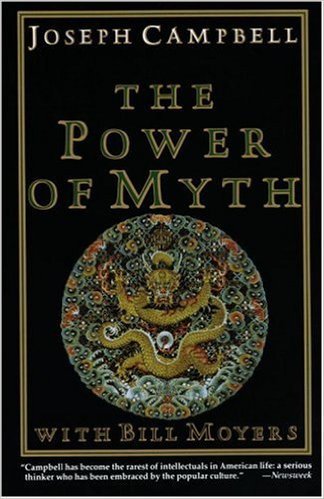 Story Forge borrows from the master of story structure, Joseph Campbell. I merged my layout with Campbell's 12 Stages of the Hero's Journey, then plugged them into the Scrivener outline feature. As a secondary project, I played around with color coding and labeling each stage of the journey based on whichever card had popped up in the layout. The end result was a 22 step outline, complete with brief descriptions on what was supposed to be happening in each step and why. Like my NaNo project, it's just a first draft. But a first draft of an outline for a complete novel in under an hour is pretty dang cool IMO.
Story Forge borrows from the master of story structure, Joseph Campbell. I merged my layout with Campbell's 12 Stages of the Hero's Journey, then plugged them into the Scrivener outline feature. As a secondary project, I played around with color coding and labeling each stage of the journey based on whichever card had popped up in the layout. The end result was a 22 step outline, complete with brief descriptions on what was supposed to be happening in each step and why. Like my NaNo project, it's just a first draft. But a first draft of an outline for a complete novel in under an hour is pretty dang cool IMO.You may be thinking this sounds a little too formulaic, but what book or movie isn't? In fact, the sociological research of Campbell and others indicates adhering to certain basic patterns contribute significantly to how much the reader/viewer enjoys the story. I figure, why mess with success? Rather than feel constrained, I feel comforted that Campbell is my guiding light so that I won't leave out any important components.
But back to the Story Forge cards: they can also be used for smaller projects. Here's an example of using them to flesh out a minor character. It requires only 7 cards. If you're doing NaNo, feel free to give it a spin and use this layout to crank out those 1667 words tomorrow.
Character 'Quick Pick'
Here's the layout, or spread:
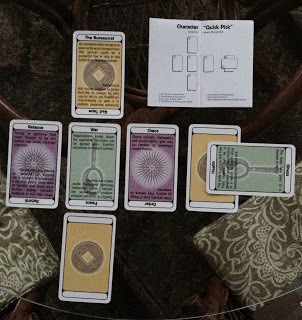
The 88 cards are grouped into six different categories. The instructions explain the meanings of the categories, suggest some spreads, and indicate what each card position in the spread represents. Here are the results for helping develop a minor character, completely at random after a few shuffles. Since the writing is a little small in the picture, I've spelled it out for you below. The card number indicates its position in the layout. Directly below is a description of the card that landed in that position as I dealt them out.
Card 1: The character's base nature
War. Negotiations break down. No equitable solutions can be agreed upon. Conflict escalates to violent combat.
Card 2: The influence of the universe
The Bureaucrat. As someone who accepts or even embraces bureaucracy, this person could be a powerful foe or ally in the political or financial arenas.
Card 3: His/her 'Achilles heel'
A Wealth card. While wealth cards can be taken literally to represent money or finance, but they can also stand for nearly anything in the physical, material world, including issues of shelter, employment or security.
Card 4: The influence of family/friends
Relapse. Forces or patterns that were thought to be left behind rise anew, stronger than ever.
Card 5: The character's driving passion
Chaos. Chaos prevails. Rationality and predictability give way to random or seemingly insane events.
Card 6. The character's destiny
Another Wealth card.
Card 7. What stands between them and their destiny
Health. The body is strong and free from disease. Can be a generally good constitution or a return to health after having been injured or sick. Notice this 7th card is laid across the 6th. Crossing cards represent a barrier or obstacle to the card they are crossing. So in this instance, there is something about the health status of the character that is preventing them from achieving that second Wealth goal.
Obviously these spreads aren't going to make sense 100% of the time. No one is suggesting you become enslaved to them and try to make their suggestions work against the grain. If you turn up a card that doesn't work, there are several options. I don't know if you can see it in the photo, but each card has two meanings, usually opposite. For example, the bottom half of the Health card is Illness. If you a card turns up that doesn't fit your needs, turn it around and try it that way. If it's still not working, draw another card. If the whole spread is a mess, reshuffle and try again.
Story Forge is just another way to get the creative juices flowing. I thoroughly enjoyed using it and will continue to do so, even though part of me keeps envisioning a scene from Tin Cup. If you haven't seen the movie, Kevin Costner plays a down-at-the-heels golf pro. Feeling some pressure about an upcoming tournament, he turns to some unusual training tools to help get back on track. He looked silly using them, but underneath all the silly tools, he had some mad skills. I like to think we have that in common.
Note: I don't have any formal affiliation with Story Forge or Campbell. I just enjoy using their products.
Published on November 03, 2015 14:39
October 9, 2015
Dam Impressive
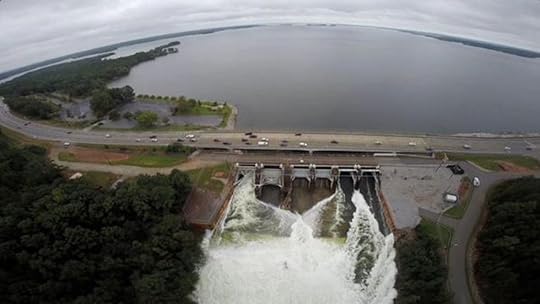 Look carefully and you can see three of the
Look carefully and you can see three of thesix floodgates, open for the first time since 1969What with all the mayhem here in South Carolina thanks to Hurricane Joaquin (which btw thank you for not making landfall - if you had, I would be composing this from my ark) I have had a host of water topics on my mind. Specifically, I have been collecting all manner of anecdotes and factoids about the massive concrete dam nearby that's keeping the 763,000,000,000 (that's BILLION in case you have misplaced your reading glasses) gallons, give or take, of water in Lake Murray from washing away most of Columbia 30 miles downstream.
 Looking south to north:
Looking south to north:Notice the original dam on the left closest to the big
water, following the greenbelt; parallel second dam
just behind it, casting a shadow Lake Murray is a 50,000 acre engineering behemoth, with 500 miles of shoreline. It's fed by the Saluda and Little Saluda rivers. Its dam is 1.5 miles long and more than 200 feet high. Walking or driving across the dam, you get a sense this thing is impregnable. Then you watch some video of the raging torrents generated by Joaquin's 1000-year rainfall, and you start to wonder.
The original dam was completed in 1930, made of our famous red clay and bedrock. Relatively recently there were some concerns that the original dam might breach, not because of water pressure, but due to earthquake activity, of all things. This area isn't generally known for earthquakes, but some small ones have occurred over the past several years, so better safe than sorry! The concrete backup dam was completed in 2005, and boy am I glad. If I had known before today that the original dam was technically 'earthen', I would've been a lot more worried for the residents of Columbia.
Last week was they had to activate the floodgates for the first time since 1969. They release water all the time to generate power, but those gates are different from floodgates. Can you imagine the heart rate of the engineer who had to push the Open button for the first time in forever with the added bonus of being the midst of one of the biggest weather crises the area has ever known? I can just see him/her: eyes closed, whispering, "please please please please please" . . .
During the flood crisis, I understand they did an emergency test of the floodgate siren that scared the ever-lovin' bejeebers out of Lexington County residents within earshot. Maybe let's work on our floodgate siren test timing, fellas?
 A closer look at the 2005 backup dam looking south
A closer look at the 2005 backup dam looking southWhen we first moved here, we eagerly devoured Lake Murray lore. Some of my favorites:
Some of the islands on Lake Murray were used as practice bombing targets by the U.S. Army Air Force during World War II. The Doolittle Raiders honed their skills on Lake Murray and elsewhere prior to their top-secret mission: the first American air strike on a Japanese home island.Bombs aren't the only thing the army dropped into the lake. In 2005 they recovered one of several bombers that crashed during practice. It's in a museum now.
 One of the B-25s recovered from Lake Murray
One of the B-25s recovered from Lake MurrayOne practice raid went awry when a business owner about 15 miles west of Bomb Island didn't get the memo there was a practice run scheduled, and didn't turn off the lights when he went home that evening. Thankfully the practice bombs were more like bomblets, filled with white powder rather than explosives, and no one was hurt.The main engineer of the original dam, and for whom the lake is named (William Murray) had a partner on the project named (wait for it): Henry Flood.When they created the lake, several communities were flooded. Homes, businesses, churches, and cemeteries are still down there under those billions of gallons of lake water. Talk about being underwater on your mortgage.Most years, one of the islands on Lake Murray is home to over 700,000 purple martins from June-September. It's such a large flock it can be seen from space. During boating season, sometimes it seems like the people-to-bird ratio is about 1:1.
I remain completely in awe of the hard work and brainpower, not to mention our tax dollars at work, that goes into these mega-projects, especially when it means keeping the lights (and the Internet) on. Nevertheless, Mother Nature sure does find interesting ways to remind us who's really the boss. Stay safe out there, folks.
Published on October 09, 2015 12:21
September 27, 2015
The Oversight Committee
 It's all about that linkSo I'm minding my own business, happy to be through with at least one of my writing projects and moving forward with the next. As per my usual, every evening before I go to sleep, I read. Lately I've been reading more e-books by self-published authors. I'm doing this to improve networking, write some reviews, and hope my fellow authors return the favor.
It's all about that linkSo I'm minding my own business, happy to be through with at least one of my writing projects and moving forward with the next. As per my usual, every evening before I go to sleep, I read. Lately I've been reading more e-books by self-published authors. I'm doing this to improve networking, write some reviews, and hope my fellow authors return the favor.And this is how I stumbled upon some previously overlooked features of the e-book format itself. I realized I had omitted an important part of the book. It wasn't one of Campbell's famous 12 stages of the Hero's Journey. No, I had those covered. It was something one could argue was equally important to the success of my book: the end matter. It was a little skimpy. I had some end matter, just not enough and not the right kind.
My book is a middle grade reader, a chapter book for older elementary students. I included a glossary of the Norwegian words that turn up in the book. I also included a discussion guide for teachers or parents. I had the requisite title page, and a throwback from my grad school days, a bibliography. So far, so good. But as I read Susan May's Deadly Messengers , and later, this post by Joel Friedlander on the Book Designer blog, I realized I had overlooked some equally important end matter.
It's all about the format, you see. A traditionally published book, a paper book, could easily still
contain this information I initially omitted. But in an e-book, the links are live, just sitting there waiting to be clicked upon, thus making the process of connecting reader with author, of promoting and reviewing said book, ever so much easier. You can thank the reader and ask them to 'click here' to review your book. You can invite them to visit your website and subscribe to your email list. You can meet on Facebook or Twitter or Pinterest or whatever else floats your social networking boat.
Insert large sigh and groan here. I wasn't looking forward to going through Scrivener's Compile process again. I hated the idea that some books had already been purchased and the buyers may never notice the update. But I knew in my heart it must be done.
That screen shot up there is a little small, so let me 'splain to you what I added to the end matter. It wasn't a whole lot. Took me part of an afternoon.
One page giving some details about how I came to write the book. Ms. May and many other authors included this. I think it gives a nice personal touch.One page thanking the reader for their purchase and outlining all the various ways they can connect with me. In my case, I gave them my website as well as email address. I reminded them to subscribe to my blog if they liked. I included a link to my Facebook and Twitter pages. Last but certainly not least, I included direct links to Amazon and Goodreads for both my author page as well as where to leave a review. Most of these links I grabbed by visiting my home page at my website/Facebook/Twitter account, then copying and pasting the URL from the URL bar in my browser. The review links at Amazon took a little more doing. If you have trouble getting this right after you read the Friedlander article, hit me up and I will see if I can help. One thing I did differently from the article: they had some pretty sweet icons for the various social networks that they used for the link, rather than a hyperlink associated with some plain text. I fooled around with that for a while, but I had a hard time finding the size and look of the icons I wanted to use. Plus, I didn't want to overload my project with graphics and as a consequence possibly earn less money per sale.
Now, I know many e-books will take you directly to a review page as soon as you finish them. But I personally have never taken the time to write the review immediately upon completion of the book. I like to ponder on it for a while first. So I think it's nice to have these links available in the end matter for convenience if a reader wants to leave a review in future.
I've set up these extra documents as templates in Scrivener so that I won't make the same mistake in my future projects. It's impossible to know if they'll actually result in additional clicks. But I feel better knowing they're included.
Published on September 27, 2015 17:59



